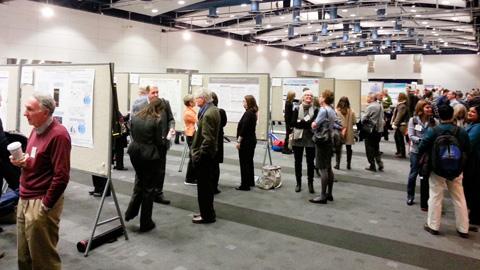Scientists throughout NCI gathered at the 2016 Intramural Scientific Investigators Retreat on Jan. 12, at the Ronald Reagan Building and International Trade Center, to discuss the results of their research with fellow investigators.
Several researchers who have made significant advances toward the goal of eliminating the threat of cancer spoke to a packed auditorium of like-minded experts. Speaker topics included the role genetics play in the risk of breast cancer, using fiberglass to determine the functions of RNAs, targeted radiation delivery, and transcription factors in early T-cell development.
Kornelia Polyak, M.D., Ph.D., from the Dana-Farber Cancer Institute, was awarded the 14th annual Rosalind E. Franklin Award by NCI’s Women Scientist Advisors. Polyak presented her research on breast tumor evolution and her specific to allele PCR fish (STAR FISH) model. The STAR FISH model is used to predict the order of genetic events throughout a tumor’s progression.
Leonard Zon, M.D., director of the Stem Cell Program at Boston Children’s Hospital and Grousbeck professor of pediatrics at Harvard Medical School, was honored with the 20th annual Alfred G. Knudson Award in Cancer Genetics from NCI.
Zon spoke about his use of the zebrafish model and its “clear” body type, which allows researchers to see cells and mark organs. Using the zebrafish model, researchers are able to see the initiation of a melanoma at the single-cell level in vivo. He developed his zebrafish melanoma model in 2005.
“Zebrafish will be a model where you can really see cancer from the beginning,” Zon said.
Researchers Share Their Science During Poster Sessions
In addition to multiple speakers, two poster sessions gave researchers the opportunity to highlight their recent achievements.
Denise Whitby, Ph.D., head of the Viral Oncology Section, AIDS and Cancer Virus Program, showcased how she and her team used “shotgun” next-generation sequencing approaches to derive whole-genome sequences of Kaposi’s sarcoma-associated herpesvirus (KSHV).
“By looking at the entire genome, we may find genetic variations related to disease risk that can be pursued,” Whitby said. “In addition, we are likely to radically change our understanding of KSHV molecular evolution. This is such a new approach that the major challenge we have is analyzing the data.”
Martin Schnermann, Ph.D., head of the Organic Synthesis Section, Chemical Biology Laboratory, presented his research focused on new agents for imaging and drug delivery.
“We are developing and using a novel platform that enables imaging and drug delivery in complex physiological settings. To do this, we take advantage of the unique properties of long-wavelength light,” Schnermann said.
Dave Heimbrook, Ph.D., president of Leidos Biomedical Research, said the retreat gives attendees a chance to network with colleagues and see how their research relates to others.
“For both the lectures and posters, I’m always amazed at the diversity of problems being explored and the approaches being taken,” Heimbrook said. “I especially like the posters, because this work is often more exploratory, and you can talk directly to the scientists doing the work and others who are interested in the topic.”
Both Schnermann and Whitby felt the retreat was a great way to collaborate with colleagues and discuss different ideas.
“I think the importance of retreats, such as the PI retreat, is the opportunity to hear and see research performed out of your own area, and, most importantly, to catch up with investigators you don't interact with on a regular basis, especially investigators from Bethesda or Shady Grove,” Whitby said.
Schnermann said the quality of the speakers was high and the poster sessions were interactive and engaging.
“It really is a great opportunity to interact both with established collaborators and to make new connections across the breadth of CCR research,” he added.
The event concluded with an afternoon session of speakers, including Charles E. Matthews, Ph.D., physical activity epidemiologist and investigator in the Metabolic Epidemiology Branch, Division of Cancer Epidemiology and Genetics (DCEG), NCI, who lectured on the effects of exercise and reducing cancer risks, and identifying the mechanisms to reduce those risks; and Gretchen Gierach, Ph.D., investigator, Metabolic Epidemiology Branch, DCEG, who lectured on breast density in relation to the risk of breast cancer.
“Breast density is one of the strongest risk factors of cancer,” said Gierach.
She added that there is legislation in progress that will require radiologists to report breast density to patients during mammograms.


